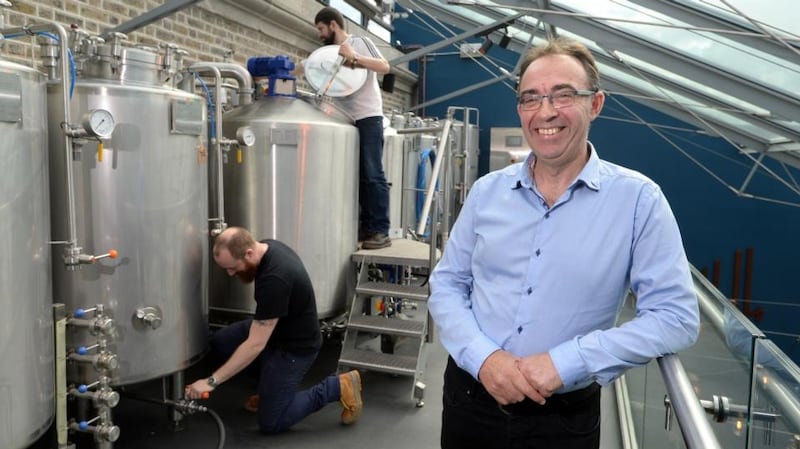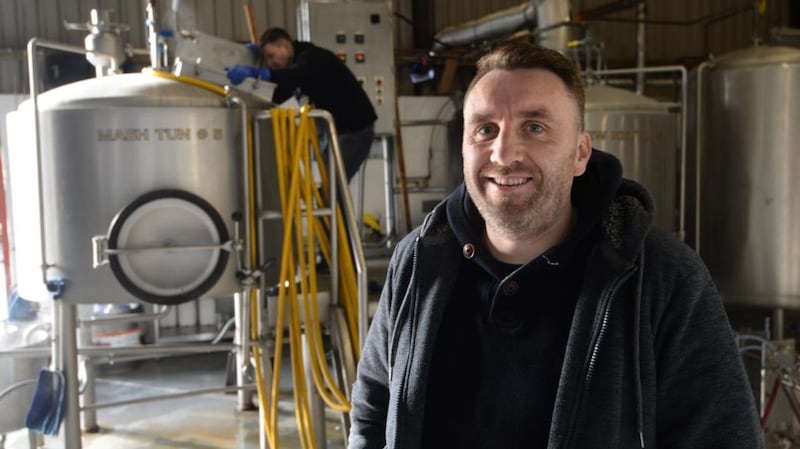There has been an explosion in the number of Irish craft breweries opening up over the past decade, with a vast and growing selection of beers now available in off-licences and supermarkets. But as the offerings expand – and the battle for shelf space intensifies – the sustainability of such a rapidly evolving industry has come into question. Is there room for all of these new craft brands or will we start hearing more about buyouts, consolidation and closures over the next few years?
“It’s become a bit crowded,” says Séamus O’Hara, founder of the Carlow Brewing Company. “It’s not that the market for craft beer has declined, it’s growing and there are new customers and lots of activity . . . but there is a sense that the pressure has come on a bit now.”
Figures released last week from the Independent Craft Brewers of Ireland (ICBI), the official trade body for independently operated microbreweries, reflect a vibrant sector facing challenging times. While output grew by 10.7 per cent in 2017, this is a significant reduction from growth rates in recent years. Output in 2016 and 2017 jumped by 31 per cent and 56 per cent respectively.
The report, issued on behalf of Bord Bia, notes that, while overall consumption of beer declined by 2.1 per cent in Ireland in 2017, consumption of craft beer rose by 12.7 per cent.
“It’s still a fledgling industry,” says O’Hara, referring to independent microbreweries’ 2.6 per cent share of domestic beer consumption [it was 2.5 per cent in 2016]. “We’re still trying to get that above that 3.5 per cent . . . the biggest challenge is breaking through that, and then it becomes more sustainable.”
While the figure of 3 per cent may sound small, he adds, he believes the number of people drinking non-traditional big brands must be about 10-20 per cent. (In the US, as a comparison, 12.7 per cent of beer consumed in 2017 was made by the independent sector.)

Closures have become a new feature of Ireland’s microbrewing industry, the ICBI report found, sounding a note of caution “over the state of the market”. There are some 125 microbrewing companies operating in the State, of which an estimated 50 are brand owners. In the past two years, seven production microbreweries have ceased operating, with five failures in the year to mid-2018. However, 10 new microbreweries entered the market over the same period.
"It's way harder to start a brewery now than it was four or five years ago," says Stephen Clinch of Trouble Brewing in Kill, Co Kildare, which was founded in 2010. "It's a very competitive market space now and has become increasingly so over the last two to three years."
What has changed? “It’s a combination of a few things,” says Clinch. Macro breweries have started releasing new products, eating into the space for craft beer, he says. There’s also increased beer imports and mid-size Irish breweries are now capable of releasing larger volumes of beer at lower price points.
“I’d be optimistic and confident for us because we are that little bit more established. I would worry for newer people coming into the space . . . There’s an inevitability that some will drop off, some weren’t that well thought out, and some unlucky with timing.”
Competition
The dominance of big, multinational brands in the Irish beer market – with significant distribution networks and big marketing budgets – is a major challenge to growth in the independent sector, the ICBI report states.
"The alcohol sector in Ireland is not a level playing field at all," says John McKenna of the McKenna's Guides. He refers to comments made by Labour TD Alan Kelly in the Dáil in July, alleging that macro breweries were engaging in anti-competitive practices around Ireland to prevent smaller breweries from selling beer to pubs.
"The dogs in street know what is happening here," Kelly said at the time. His comments were refuted by Minister of State Pat Breen, however, who said that, "after a robust examination", the Competition and Consumer Protection Commission had found it did not have grounds to suspect a breach of the law.
"We are aware that big companies are offering pretty large incentives to stock their brands – the mainstream brands – but what you find is that most publicans will want to offer choice and range," says Donall O'Keeffe, chief executive of the Licensed Vintners Association (LVA), which represents Dublin pubs.
“At the end of the day, it’s the customer that’s going to decide what’s successful here,” he says. “Our understanding is that, nationally, craft beer in the on-trade will be about 4 per cent in 2018. We think the urban centres in Dublin are higher than that probably, somewhere in the 4-6 [per cent] range. ”
Craft-style products
New product releases from the big breweries have also exerted pressure on the independent sector. “We’ve seen some of the bigger players respond with craft-style offerings that are playing more into the craft space . . . but [the smaller breweries] are competing with each other more than they are with the big guys,” says O’Keeffe.
Recent releases from the bigger players include Rockshore Lager by Guinness, and Archway Lager made by Franciscan Well, which is owned by Molson Coors.
“There’s seem to be a bunch of new product launches in the past 12 months from the big guys,” says O’Hara, “so that’s an added hurdle for all of us . . . But the only good thing about the big guys muscling into the space is that it probably brings more customers in the craft/speciality space.”
Guinness is also courting the craft beer audience with its Open Gate brewery for experimental and smaller batch beers.
"We have 13 taps and cask, with two rotating guest taps, and we've featured local Irish breweries including Four Provinces and Dot Brewing, " says Open Gate manager Pádraig Fox. Are Diageo eyeing up a few smaller breweries to buy out? "It's not in the plan," says Fox.
Last year Cork's 8 degrees was bought by Pernod Ricard, while C&C completed its purchase of Five Lamps in 2017. Though there have been a few high-profile acquisitions in the UK involving Camden Town, FourPure and Beavertown (which sold a minority stake to Heineken), activity on this level in Ireland has been subdued so far.
Clinch of Trouble Brewing believes that independent breweries need to do more to clearly distinguish themselves from macro brands. “The bigger [macro-produced] beers are muddying the waters . . . With so many different brands now, it can be hard for people to know what’s what and I think we need to make it easier for them.”

The off-trade
Trying to find space on the off licence shelf will be one of the biggest challenges for breweries over the next while, Paul Barry reckons.
An assistant buyer in beers and spirits at O’Brien’s off-licences, he says: “In some of our stores we would have tripled the craft space in the past four years. There’s a lot of product out there and not everything can fit.” .
But with demand increasing, he believes the market is “absolutely sustainable”.
“Many customers I talk to say: ‘I’ll never go back to a macro lager or to what I’d been drinking previously.’ They’ve caught the craft bug,” says Barry, whose O’Brien’s network has 34 stores around the State. While the IPA is overwhelmingly the best-selling style of beer, he says, “there’s more niches being carved out for different styles”.
Different audiences
Dot is a contract brewery in Dublin, specialising in barrel-aged, small-batch beers. "Everyone is carving out their own identity," says founder Shane Kelly. "Ageing and blending beer is a niche within a niche but those niches exist elsewhere, so we're not just solely focused on the Irish market."
Currently exporting to Netherlands, Finland, Sweden, Dot is due to export to Russia, France, Britain and Italy in 2019.
The export market is largely untapped by Irish microbreweries, with some 58 per cent not currently exporting. Four microbreweries accounted for 75 per cent of all exports by volume in 2017. Many, particularly outside Dublin, have a more local focus, such as the Burren Brewery or Western Herd in Co Clare, or 9 White Deer in Cork. On average, 56 per cent of sales are within a 50km radius of breweries.
"Having your own platform is very important," says Adrienne Heslin of West Kerry Brewery, who runs a pub serving five of their own beers on draft. Being on the Wild Atlantic Way has increased their footfall, with more and more people asking for local beer, she says. "People are coming in for our beer. We're a destination and I don't see why every brewery in the country can't be a destination."
Taprooms
Legislation introduced earlier this year, which allows for the sale of alcohol to visitors to breweries, has given a major boost to the sector.
“This changes the battlefield entirely,” says McKenna. “Traditionally, the dialogue about alcohol in Ireland was always concerned with the pub. This shifts it out of the pub and brings into the brewhouse, the cider house, the distillery and gives them a whole other opportunity.”
McKenna likens taprooms to farmers’ markets: “The farmers’ market rescued so many artisans because it gave them the ability to deal directly – not just to the supermarket – and make money.”
There are restrictions on the operational capacity of taprooms, which some breweries have said will limit its appeal, such as the permitted opening hours (10am-7pm). And there are significant costs involved in applying for a licence.
There is undoubtedly huge scope in terms of tourism, however, particularly in terms of brewery tours and tastings. It’s a massive opportunity for the industry, believes Mc Kenna. “The potential here is to create something along the lines of the bourbon trails in Kentucky.”
Key figures from the industry
€44.3 million: Total turnover of craft beer producers in 2017
5.2 per cent: Average alcohol content of Irish craft beer products
157,000: Number of hectolitres of beer produced in the independent craft beer sector in 2017
€1 million: One in five microbreweries had turnover in excess of €1 million
Source: ICBI on behalf of Bord Bia, Irish Food Board











